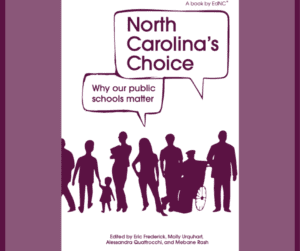Check out the full NC Local newsletter from Sept. 15 for more on this story and to read about The News & Observers newest editor, accolades for journalists across the state and more. Sign up to get NC Local in your inbox every Wednesday.
By Eric Frederick, NC Local Newsletter Editor
When Poynter’s Kristen Hare wrote recently about places where college journalists were going off campus to help fill news and information gaps in nearby communities, I was reminded of similar things happening here in North Carolina.
I reached out to more than a dozen places in the state where college students are helping to inform communities off campus, and I heard back from several of them. Here’s what they’re up to:
Queens University
The Queens University News Service was created by former Charlotte Observer editor Rick Thames, visiting professor and executive in residence in the Knight
School of Communication at Queens, and Bob Page, the school’s director of digital projects and advisor to student media. It is aligned with the Charlotte Journalism Collaborative, a partnership of 10 news and information outlets in the area.
“The service provides coverage of issues that media organizations would like to cover, but lack the resources and personnel,” Page told me by email. “Stories include criminal justice and police reform; art; faith-based communities and their engagement with the city; the environment; and non-profit organizations. Students create textual stories, photography, and video stories, and are guided and edited by faculty and staff.” More than 90 percent of their work is published, he added.

Aside from helping students get the experience needed to secure paid internships, the service does fill community news gaps, Thames said. “Our media partners take as much or as little as they’d like,” he said. “We welcome their feedback and invite them to tell us about areas of coverage they need but can’t provide.”
A couple of examples are Grace Wesoly‘s story on the area’s Faith in the Vaccine initiative, and Elvis Menayese‘s report on the effort to expand the tree canopy in low-income Charlotte neighborhoods.
Read more here on what Queens University News Service is doing.
Duke University
At The Chronicle, campus news is the priority — including a determination “to hold Duke accountable and make sure they know that we are here to advocate for students, faculty and staff,” EIC Leah Boyd told me. But “better prioritizing Durham coverage is always a conversation,” she added.
“We branch out into Durham when there are big events happening, like elections, which we’ll be facilitating coverage on this year, and we’ve spoken to North Carolina Central University about forming a partnership to bolster our coverage of Durham news and better understand the relationship between our two universities.”
You can find much of The Chronicle’s community reporting, including profles of Durham City Council candidates, on its local/national news section.
Read more here on what The Chronicle is doing.
Also at Duke, students in the DeWitt Wallace Center for Media & Democracy in the Sanford School of Public Policy produce The 9th Street Journal, which covers Durham city and county news and reported on the 2020 election. Their work is edited by veteran journalists Bill Adair and Stephen Buckley on the faculty, as well as “a few seasoned student editors,” Adair told me by email. Along with the Journal’s website, the stories are published in Indy Week.
“We think of it as a teaching laboratory,” Adair said. “Our students get valuable experience … by covering City Hall, the courthouse, county government and local businesses.
“Our goal is helping them learn rather than covering every important story in Durham. So we often don’t focus on breaking news. That’s a tradeoff we have to make because of the academic calendar and limits on student time (and ours!). We publish about one to two stories per day during the semester, which provides valuable news and features for Durham residents (they learn about it through our weekly email newsletter, our Twitter feed or by reading our stories in Indy Week).”
Read more here on what 9th Street Journal is doing.
UNC-Chapel Hill
At The Daily Tar Heel, it begins with listening.
The “most simple yet crucial thing,” EIC Praveena Somasundaram told me, is to “let community members know that we want to report on what they want to know.” The DTH solicits community needs in several ways, she said, including surveys, social media callouts, attendance at meetings and events in the community, and soon — COVID permitting — open newsroom hours. She also cited a recent column by City and State Editor Guillermo Molero that invited feedback on needs in local election coverage.
The DTH team also produces the OC Report, a weekly Monday newsletter that serves full-time residents of Chapel Hill, Carrboro and Hillsborough (you can see its latest reporting and sign up on its web page), and the weekly Elevate section, which reports on and amplifies the voices of underrepresented people in Orange County communities. Elevate is one project enabled by the Sharif Durhams Leadership Program, a talent and leadership development course for DTH staffers from underrepresented groups.
Read more here on what The Daily Tar Heel is doing.
Also at UNC is Media Hub, a course for seniors in the journalism and media school where students are expected “to produce journalism on par with professional journalists,” said John Robinson, former editor of the News & Record in Greensboro, who teaches it as a professional in residence at the school.
“Each class has 20 students, with a mix of ‘print’ reporters, broadcasters, graphic artists, photographers and marketing students,” Robinson told me. “I mix them into cross-functional teams, and they work together to produce stories that the marketing students pitch to professional media outlets.
“We emphasize finding stories that haven’t been told, or haven’t reached a large audience, and exploring them in-depth.”
The stories are free for news outlets to use, with credit to Media Hub and UNC. Professional outlets published the hub’s work 103 times last fall, Robinson said. One video report by Erin Jenkins, Child Brides? North Carolina has a problem, won a national Edward R. Murrow Award for Excellence in Video Hard News.
News organizations can find Media Hub work at the hub’s website and can also make contact by email.
Read more here on what UNC Media Hub is doing.
UNC-Asheville
The Blue Banner focuses on its main audience — the students at UNCA — but that includes “how their role as community members affects them,” social media editor Olivia Alpert said. That means reporting on “Asheville as a whole” through a student lens.
“When writing or posting about the Asheville community, it is imperative that the subject at hand correlates somehow to our student body, faculty and staff,” she said. One recent example of The Blue Banner’s community coverage is a story by staff writer Roy Inkidar on a redevelopment plan in an Asheville neighborhood, where activists wanted students to get involved.
“We are constantly trying to shed light on local social injustices and policies,” Alpert said. “We have been covering COVID almost every day, and the plethora of ways in which the pandemic has affected student lives and the lives of others.”
Read more here on what The Blue Banner is doing.
Elon University
“Elon News Network‘s mission is to serve the community,” ENN executive director Kyra O’Connor says, as Alamance County “is by and large a news desert. Nearby towns such as Gibsonville have no source of news. Burlington has one source of news. In Elon, we are the only source of news. It is a huge responsibility to cover local politics such as our Board of Aldermen, or protests against racism in nearby Graham …
“But we often find the most amazing stories off our own campus, so while it is a responsibility we do not take lightly, it is also an opportunity we relish to be able to tell even more stories.”
The network delivers information through three broadcasts per week — ELN Morning, Elon Local News and The Online Exclusive — plus a weekly print paper (The Pendulum), a regularly updated website, a weekly podcast and social media. You can access the broadcasts and podcasts on the website.


A recent example of community coverage is this well-reported story by Nyah Phengsitthy on the Alamance-Burlington School System’s virtual school, addressing issues involved with remote learning as well as the digital divide.
Read more here on what Elon News Network is doing.
From the syllabus
Financial challenges
➵ Many journalism students who get graduate degrees don’t earn enough to make any progress paying off student loans, The Wall Street Journal found.
➵ But take heart. WSJ’s Julia Carpenter, in a conversation with Taylor Blatchford for Poynter, offers advice on personal finances for young journalists.
Issues
➵ An investigation by the Asian American Journalists Association’s Voices 2021 team finds that Black and Latinx students are underrepresented in college newsroom leadership.
➵ On the fifth episode of the Bridging the Gap podcast, produced by The Chronicle at Duke and by The Bridge, an online publication and social media outlet at Duke and UNC, Chronicle managing editor Nadia Bey turns the lens on her own newsroom, analyzing its relationship with Black students.
Daily challenges
➵ Some advice and a pep talk for college journalists who feel as if no one is paying attention — from Poynter’s Barbara Allen.
➵ From Taylor Blatchford: How students and early career journalists can approach potential mentors with intention and respect.
Self-care
➵ Journalist and author Anne Helen Petersen on how student journalists can guard against burnout as they embark on a career.
➵ Here’s where to get the student edition of TrollBusters’ guide to staying safe online and off.
➵ Here’s a mental health toolkit designed by and for student journalists.
Resources and opportunities
➵ Here’s the Student Press Law Center’s outstanding collection of resources for student journalists.
➵ Dow Jones News Fund offers paid summer 2022 internships for college journalists in data and business journalism, digital media and multiplatform editing. [Apply by Nov. 5.]
➵ Taylor Blatchford, who writes a newsletter for student journalists, The Lead, in partnership with Poynter, is looking for paid guest writers. [Make your pitch.]
➵ The College Media Association is taking its fall national convention virtual, Oct. 14-16. (It had been scheduled for New Orleans.) Watch @collegemedia for updates.




